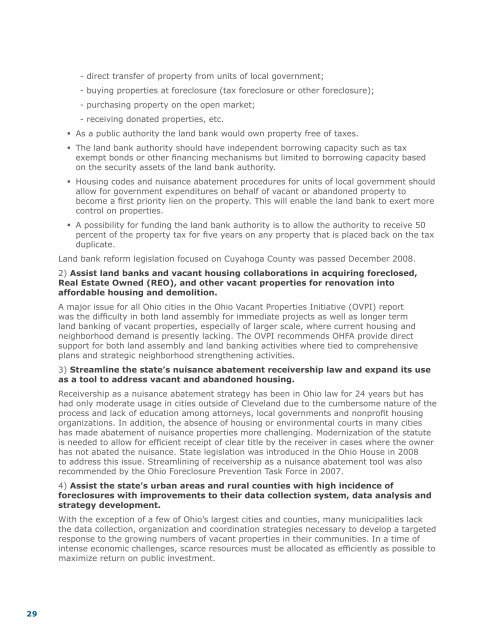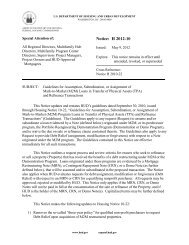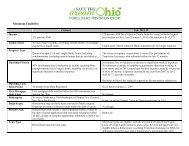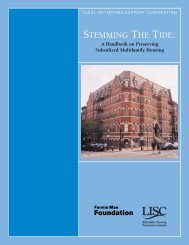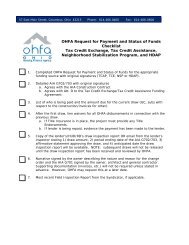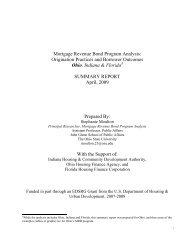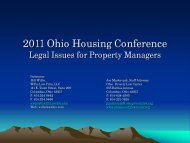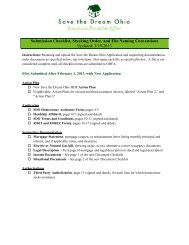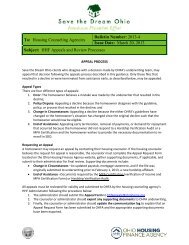OHFA Annual Plan - Ohio Housing Finance Agency
OHFA Annual Plan - Ohio Housing Finance Agency
OHFA Annual Plan - Ohio Housing Finance Agency
You also want an ePaper? Increase the reach of your titles
YUMPU automatically turns print PDFs into web optimized ePapers that Google loves.
- direct transfer of property from units of local government;- buying properties at foreclosure (tax foreclosure or other foreclosure);- purchasing property on the open market;- receiving donated properties, etc.• As a public authority the land bank would own property free of taxes.• The land bank authority should have independent borrowing capacity such as taxexempt bonds or other financing mechanisms but limited to borrowing capacity basedon the security assets of the land bank authority.• <strong>Housing</strong> codes and nuisance abatement procedures for units of local government shouldallow for government expenditures on behalf of vacant or abandoned property tobecome a first priority lien on the property. This will enable the land bank to exert morecontrol on properties.• A possibility for funding the land bank authority is to allow the authority to receive 50percent of the property tax for five years on any property that is placed back on the taxduplicate.Land bank reform legislation focused on Cuyahoga County was passed December 2008.2) Assist land banks and vacant housing collaborations in acquiring foreclosed,Real Estate Owned (REO), and other vacant properties for renovation intoaffordable housing and demolition.A major issue for all <strong>Ohio</strong> cities in the <strong>Ohio</strong> Vacant Properties Initiative (OVPI) reportwas the difficulty in both land assembly for immediate projects as well as longer termland banking of vacant properties, especially of larger scale, where current housing andneighborhood demand is presently lacking. The OVPI recommends <strong>OHFA</strong> provide directsupport for both land assembly and land banking activities where tied to comprehensiveplans and strategic neighborhood strengthening activities.3) Streamline the state’s nuisance abatement receivership law and expand its useas a tool to address vacant and abandoned housing.Receivership as a nuisance abatement strategy has been in <strong>Ohio</strong> law for 24 years but hashad only moderate usage in cities outside of Cleveland due to the cumbersome nature of theprocess and lack of education among attorneys, local governments and nonprofit housingorganizations. In addition, the absence of housing or environmental courts in many citieshas made abatement of nuisance properties more challenging. Modernization of the statuteis needed to allow for efficient receipt of clear title by the receiver in cases where the ownerhas not abated the nuisance. State legislation was introduced in the <strong>Ohio</strong> House in 2008to address this issue. Streamlining of receivership as a nuisance abatement tool was alsorecommended by the <strong>Ohio</strong> Foreclosure Prevention Task Force in 2007.4) Assist the state’s urban areas and rural counties with high incidence offoreclosures with improvements to their data collection system, data analysis andstrategy development.With the exception of a few of <strong>Ohio</strong>’s largest cities and counties, many municipalities lackthe data collection, organization and coordination strategies necessary to develop a targetedresponse to the growing numbers of vacant properties in their communities. In a time ofintense economic challenges, scarce resources must be allocated as efficiently as possible tomaximize return on public investment.29


